“Unfortunately, because it’s been so cold here recently, all the water in the hotel is frozen, so there’s no possibility of taking a shower.” said Usha. Everyone who had signed up for the Trans-Nepal Gravel event knew in advance that getting a shower in hotels located at the higher altitudes wasn’t going to be possible, so we had come prepared with wet wipes and hand sanitiser a-plenty. It’s still a bit of a shock though when reality hits, particularly when you’ve had a long, dusty journey to get to the hotel. But if you want to come and visit the Forbidden Kingdom of Mustang in the off-season, this is one of the compromises you have to make. In Part Two of Olly’s story, after four days of travelling, the team have finally reached the start line of the Trans Nepal Gravel. It must be downhill all the way to the Indian border now, right? Read on to find out…..
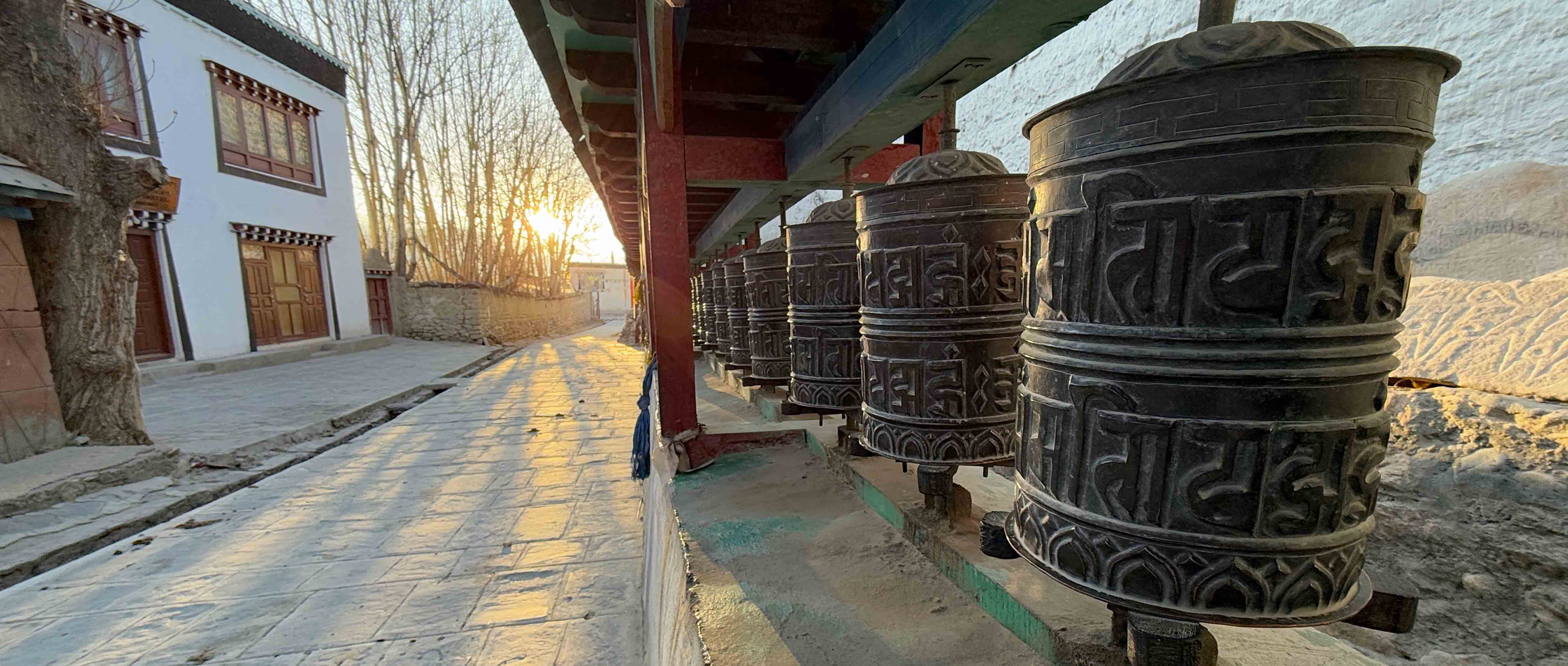
Something strange happens when you gravel ride through Upper Mustang – time appears to shift. What day of the week it is stops being important. Going to bed at 8 pm becomes perfectly acceptable. Your body wakes up as the sun eases gently over the skyline and the temperature in your hotel room lifts ever so slightly. You ride through numerous immeasurably ancient mountain-top villages that seem to have come straight from the pages of an ancient history book. The landscapes constantly boggle your brain. You can see millions of years of rock strata exposed courtesy of a combination of water erosion, frost-thaw action and the ever-present wind. Being able to peer back into the mists of time becomes so commonplace that after a while you start to take it for granted.
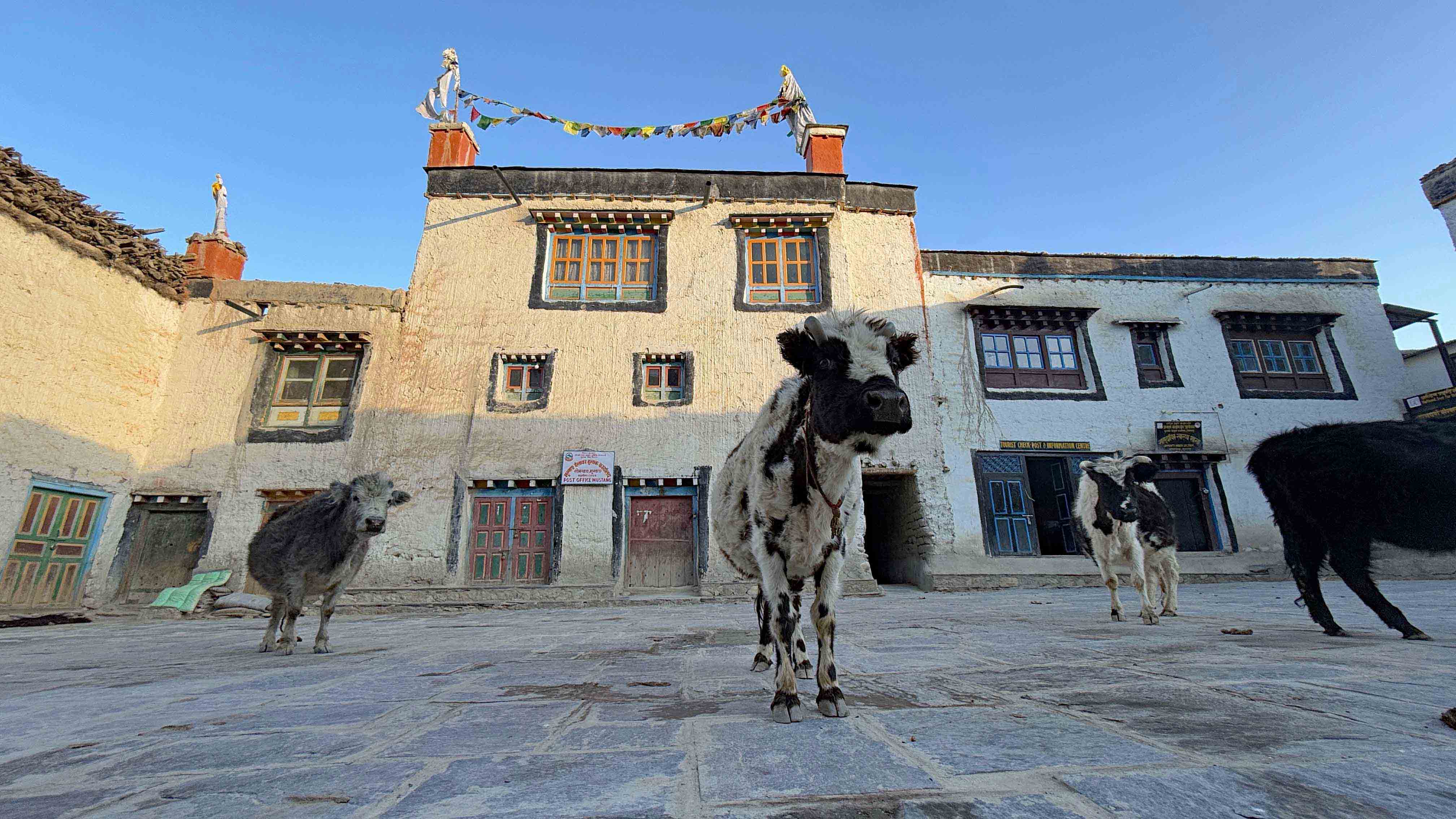
Even considering the fact that we were all now experienced gravelly time travellers, Lo Monthang, the ancient capital of the Kingdom of Mustang was still incredible. Walking around its narrow, stone-flagged streets at sunset or sunrise was an absolutely magical experience. But ultimately, we were not in Nepal to do a cultural tour of Lo Monthang, we were there to ride from the Tibetan border at the far north of Nepal to the Indian border in the far south. Or at least we would have done, if Chinese officialdom hadn’t spoiled our party with their bureaucracy. Instead of starting right at the border, we had to start at the nearest military checkpoint to the south instead – not the end of world, but now our trip had to be called Nepal Top to Bottom (ish) which didn’t sound quite as good!
"The pee bottle was still a worthy inclusion."
The view from our new starting point was stunning though. After the previous night, where temperatures inside the hotel dropped so low that we woke up with ice on the inside of our bedroom windows, everyone assumed that it would be equally baltic at the start point too. There had been many discussions on the pre-event WhatsApp group chat about what type of hand/foot warmers was best, whether a set of down trousers would be a worthwhile investment and the advantages of bringing a ‘pee bottle’ to avoid having to get up in the night and walk through a frozen hotel to find the squat loo. The pee bottle was still a worthy inclusion, but once the sun came up each morning, the temperatures ‘felt’ significantly warmer than I had been expecting. I put ‘felt’ in inverted commas because it was actually still properly cold – significantly below zero, but the absence of any kind of moisture in the air meant it actually felt like ‘good cold’ rather than the bone chilling cold that on occasions typifies the winter in the damp old UK!
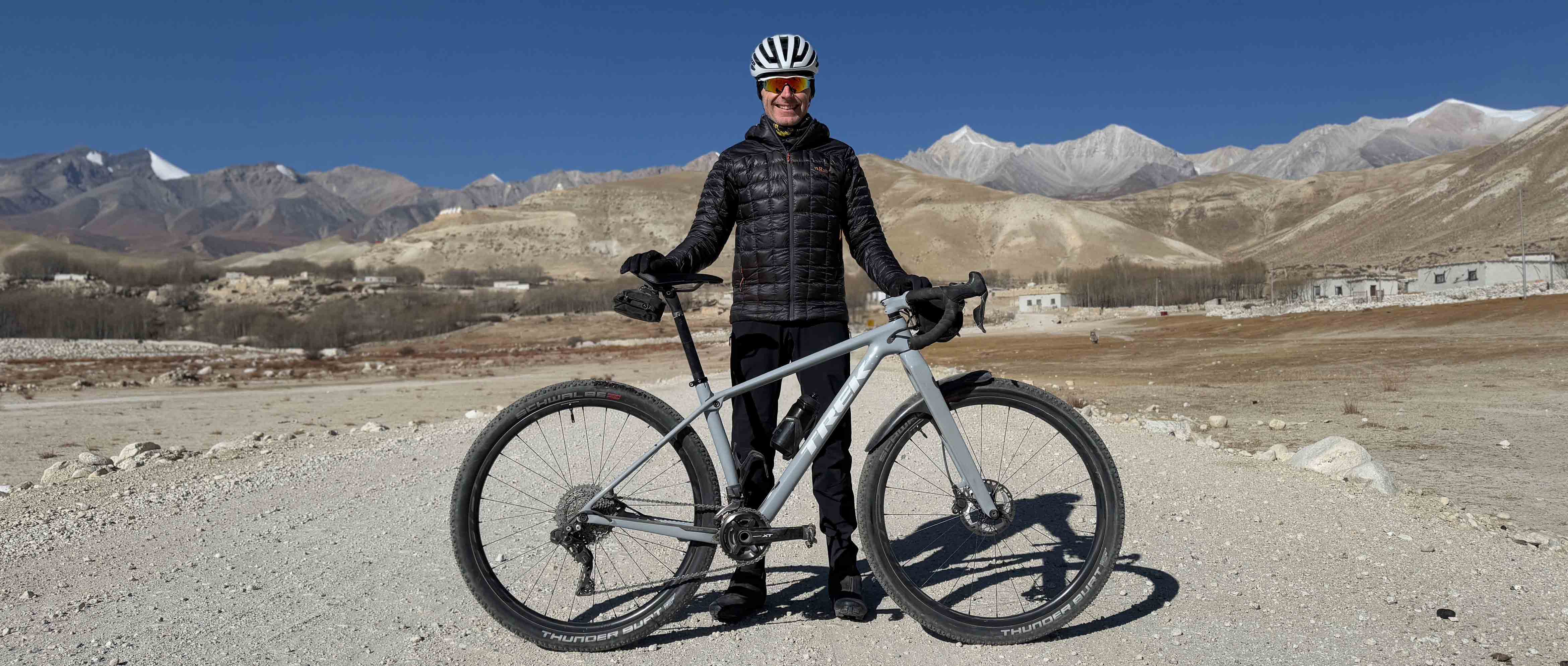
After the customary team and individual photos had been taken, we lined up for the off. Seeing as we had already spent four days riding together by this point, there was much less of the usual nervous anticipation in evidence at the start. We had more-or-less figured out everyone’s place in the unofficial pecking order during each ride and that gave the start itself a laid-back air. At least it gave everyone else a laid-back start. I had a last-minute technical hitch which meant I set off two minutes behind the peloton and then had to chase like crazy to try and catch back up. It meant that I was soon warmed up at least!
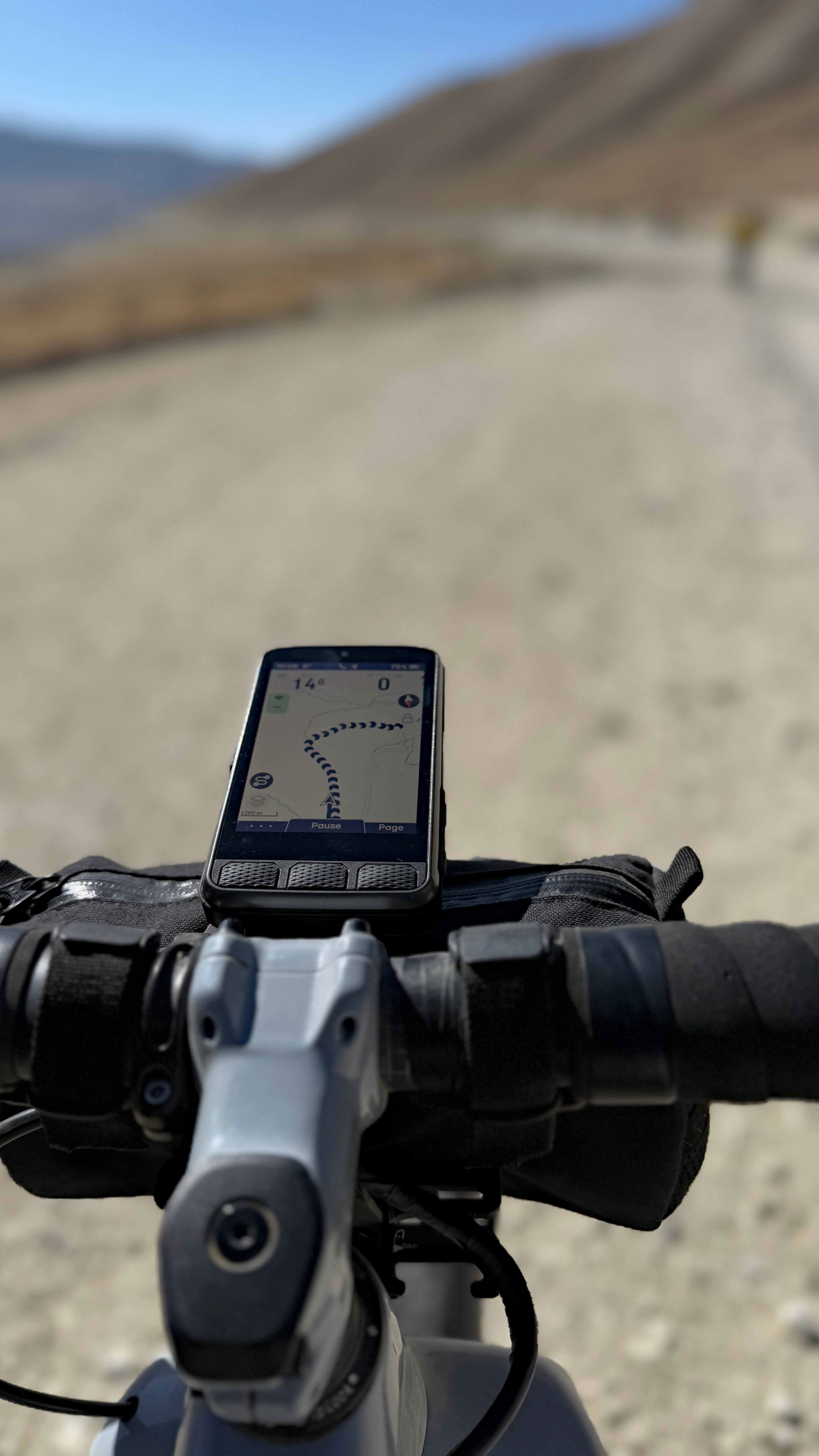
The unusual way in which the event timetable worked, where essentially the four days we spent travelling ‘up’ to the start line was also going to be route we cycled on the way ‘down’, meant we had got a sneak preview of the trail conditions and for anyone with some good trail memory, it gave us a good idea what to expect. We had all been given excellent GPX files, with the route designed and reccied by the team who were now managing us on the road, but it was still useful (at least from my perspective as a photographer) to know roughly what was coming up next. I had mentally earmarked some locations where I wanted to capture images/video, so after my brief chase back to the peloton, it was ‘game on’ for the rest of the day’s ride.
"There were definitely times where I would have sold my soul for some electric assistance."
The initial part of our route was fast-rolling, relatively smooth and had a broadly downhill trend. We were heading back to Lo Monthang first and I had remembered that the route just before the city itself included a very fast, rocky descent, followed by a short, steep, loose climb back up into the city. I was alternating between capturing stills and shooting video, some of which was done with a small video camera that I gripped between my teeth! Loose rocky descents are a nightmare to photograph well, so I opted for video mode, but then pushed my heart rate way beyond its normal maximum on the subsequent ascent in order to get some stills of riders cresting the top of the climb. There were definitely times where I would have sold my soul for some electric assistance to make getting in front of the riders a little easier, but with none available, it was down to some stubbornness and determination to get me there instead!

As we exited Lo Monthang for the last time, we started the first of two big climbs scheduled in for the day. If the city had appeared to leap straight from the pages of a Robert Powell book, then the remainder of the next few days appeared as though we were riding through one of my sister’s incredible landscape paintings! The scenery was absolutely stunning, with earthy tones, dramatic erosion lines, stratified geology and an azure blue sky in the background. The landscape in fact did its best to distract us from the pain in our legs and lungs! The climb, although not super steep, was impressively tough. Whereas on our route north to the start line we had predominantly had the wind behind us, now we were heading south we had the opposite. We were fortunate at least in that much of the climb was hairpinned and that meant after alternate turns we had the wind on our backs.
The total distance of our route for the day was a little under 40 km, but what it lacked in length, it made up for in quality and in scenery. Although the majority of the way was sparsely populated and quite austere, there were a couple of villages which we passed through including Charang, the site of our water/feed stop. The village had an incredibly Tibetan feel to it with whitewashed houses, piles of firewood drying in the sunshine and flagstone lined streets in the central section. As we rode right through the centre, the local people greeted us with a mix of shock and friendliness. The main jeep trail bypassed the centre, so we guessed that not many western tourists ever came to explore the village itself.
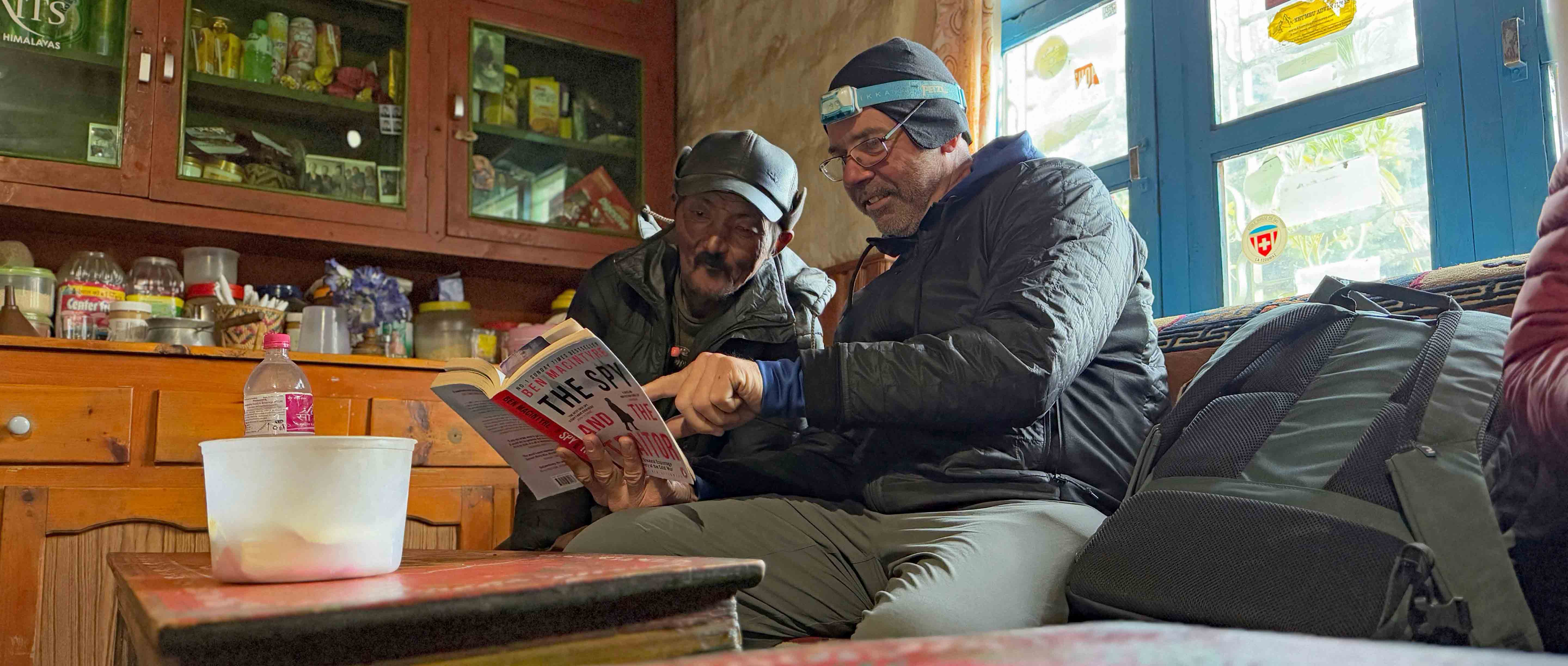
Our overnight accommodation was in Ghami, where we had stayed a few nights previously. The friendly welcome hadn’t diminished any since our first visit and there was something comforting about knowing how things worked, including the fact that the dining room would be heated in the evening, something that had been sadly missing in Lo Monthang! The accommodation appeared to also serve as a roadside cafe and a shop for local people and we received the normal initially-bemused-then-curious-then-friendly welcome from the locals. Dom did his best to explain the plot of a cold war spy novel that he was reading to one of them. Despite the fact that the man didn’t understand a word of English, he was fascinated by the book and kept carefully turning from one page to the next.
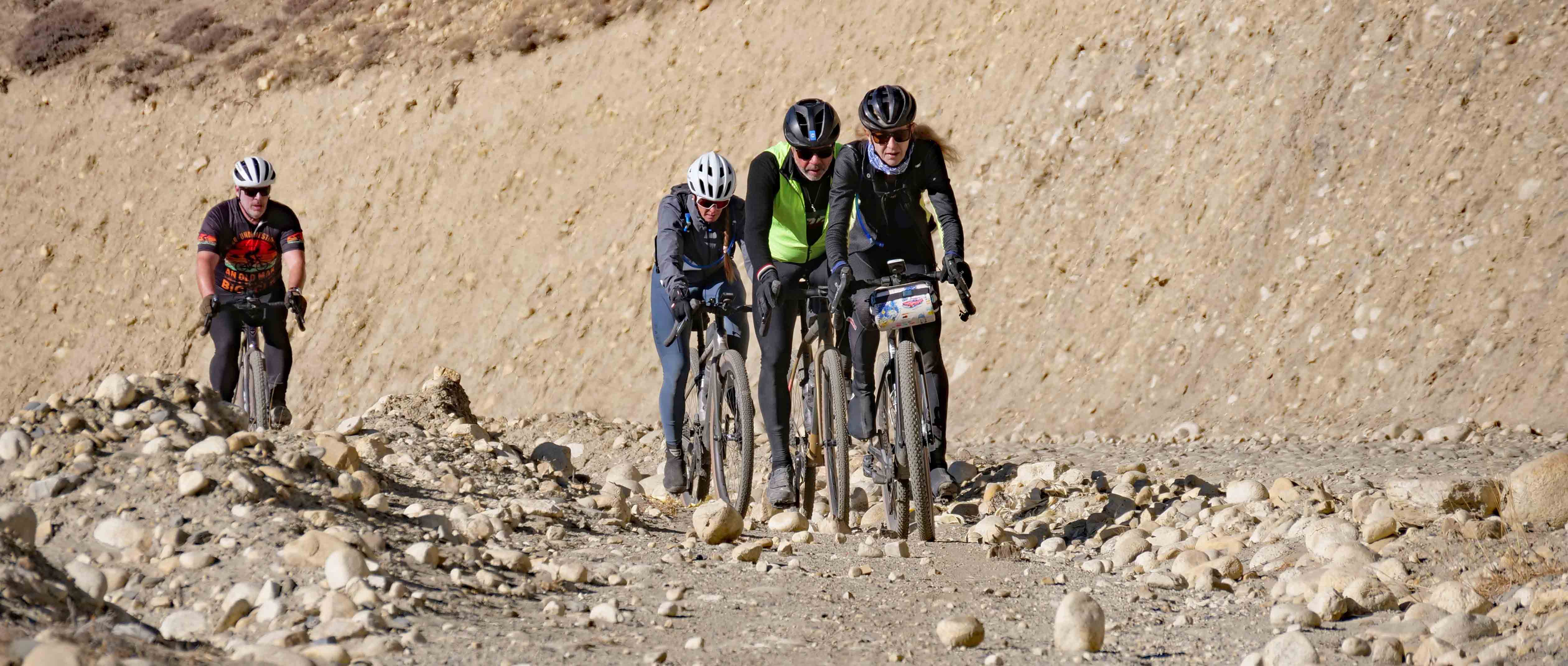
Day Two included two passes which just touched the 4000m mark and the climbing started straight from the front door. When we had ridden north during our transit days, the route leading into Ghami had stuck in everyone’s minds as it had been so jarring, but many of us had noticed some sections of smoother trail off to the side of the main driving route. As we winched our way back up this trail, anyone with enough spare mental capacity (not easy, when riding at nearly 4000m) skipped from one side of the trail to the other in search of the smoother lines.
"I was slowly winching Kevin in, but a few hundred metres before the top he suddenly stood up and put some extra power through the pedals."
Long climbs can be quite a solitary experience – everyone has their own speed after all and having to change your rhythm significantly to match someone else’s pace (whether faster or slower) is actually harder than just being steady-Eddy. As I got closer to the 4000m pass that was the high point of the first climb, I could see the distinctive figure of Kevin not that far ahead of me. Whereas the sensible bit of my brain was telling me to continue tapping out my metronomic rhythm, the photographer in me knew that I wanted to try and capture an image of him as he crested the climb. Kevin’s power and determination was incredible and catching him was no mean feat. As the summit loomed ever closer, I was slowly winching him in, but a few hundred metres before the top he suddenly stood up and put some extra power through the pedals. It took a superhuman effort to close the gap to him again and with mere seconds to go before the top I managed to edge past just enough to capture some images of him cresting the summit.
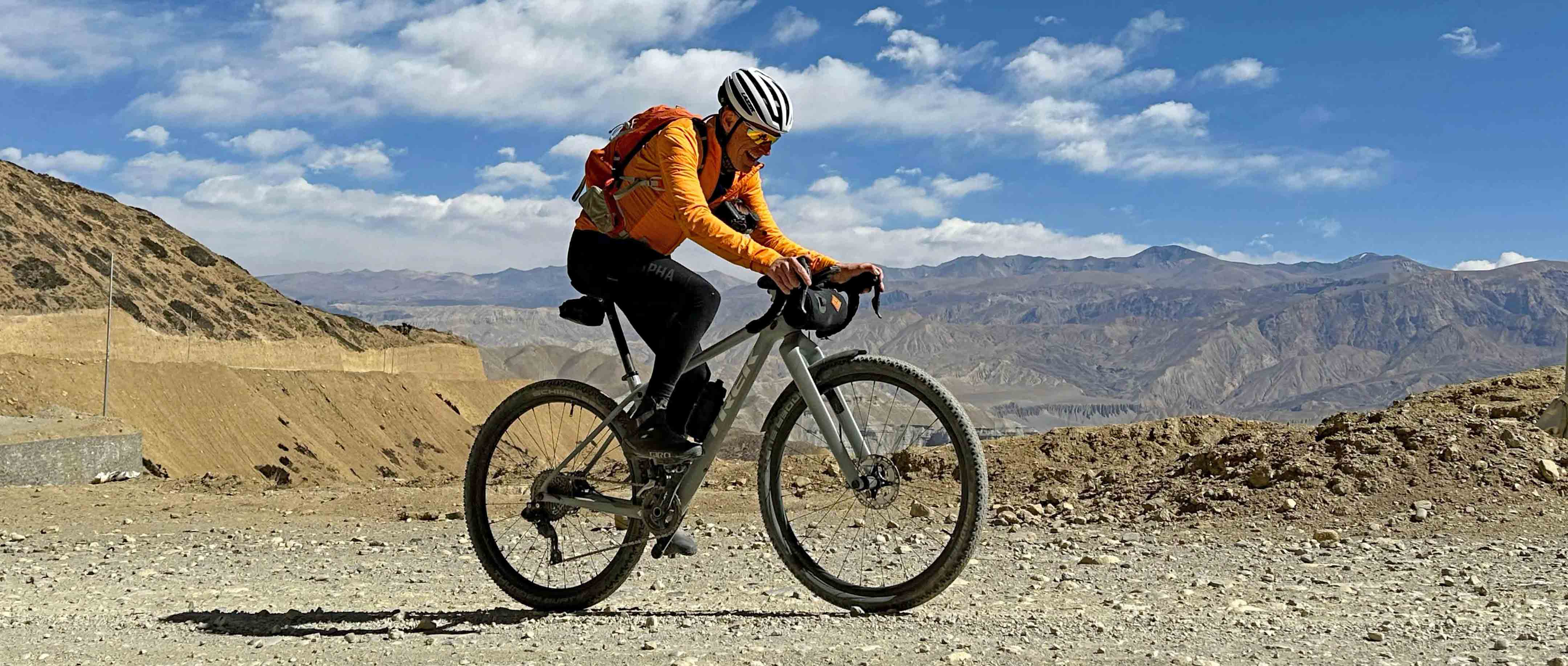
Image courtesy of Usha Khanal
I don’t remember much about the subsequent descent except that it was super windy, loose and fast. It was also short-lived and it wasn’t long before we started climbing again. As I slowly worked my way up through the group, I caught up with Usha, our lead guide and we ended up riding together for the rest of the stage. We took it in turns to share the ‘work’ of riding into the headwind and by utter luck our individual speeds seemed to sync perfectly. As well as being former Nepali XC and DH MTB champion, Usha is a very talented photographer and she managed to capture this image of me nearing the second and final 4000m pass of the day. It’s one of those fantastic images which is basically a complete lie – it looks as though I’m smiling and happily pushing a big gear in order to get over the second big pass, but actually I was dying and it was only because I could see the high point just in front that I managed a half smile/half grimace!
"I finished the day with a huge smile on my face and some incredible memories of racing a champion down a Himalayan mountainside."
We crested the summit together and headed down the other side, heading for our first water/snack stop of the day. The crew had set up near the village of Ghilin and it was the perfect opportunity to take on-board some extra calories, replenish our water bottles and adjust clothing. After a short rest, we set off again, heading for our next goal – an 18 km descent! Very few people will have ever ridden an 18 km off-road descent. If you were riding in the high Alps/Dolomites in Europe, you might find a paved descent this long, but I can’t think of any off-road ones as long or as sustained as this one. Over the course of the descent, we lost nearly 1000m. Although it was vehicle width, it was by no means easy. The surface changed constantly and varied from sandy, to pebbly to rock-strewn. Trying to hold the wheel of a gold medal winning downhill champion was never going to be an easy task, but I gave it my best shot! I don’t have many photographs of the descent, because my sole aim was to get to the bottom in one piece, not puncture and not do anything stupid. Even trying to ride within my limits, I still managed to finish the day with a broken spoke in my rear wheel. More importantly, I finished the day with a huge smile on my face and some incredible memories of racing a champion down a Himalayan mountainside.
Our overnight accommodation was in the spectacular village of Chhusang. Located at an altitude of just under 3000m and with a backdrop to die for, this was still a dose of Upper Mustang heaven. The ride into the village was along immeasurably ancient stone flagged alleyways between buildings constructed from rock and mud hewn from the nearby Kali Gandaki river valley. After the barren high-altitude desert feel to the landscape around Lo Monthang, Chhusang in comparison felt like an oasis. A large orchard of beautifully maintained apple trees was laid out on a terrace below our hotel. We were greeted at the hotel by our amazing crew bearing the traditional steaming mugs of hot, black, sweet tea followed shortly after by bowls of veg noodle soup (the perfect post-ride meal). Our bags had already been delivered to our rooms and with big smiles on their faces, they told us that tonight we would have the luxury of a hot shower! While I suspect our definitions of “hot” probably differed somewhat, at least we were able to get clean and the drop in altitude offered a pleasant rise in the air temperature too. At dinner that night we shared tails of our day – a local dog that loyally followed Jen for mile after mile up the first pass; wind so strong that it nearly blew some of the riders off their bikes; traversing a north-facing waterfall which thanks to the winter temperatures had turned into inches-thick sheet-ice where its path intersected with the road; the joy of arriving into the village of Chhusang and being able to shake the tiredness out of our bodies after such a long and tiring descent. Many a celebratory beer was sunk that evening.

Day Three dawned, as usual, with bright blue sky and sunshine, but with a cold wind blowing up the valley from the south. The route profile was predominantly down, with a vast descent to finish the day off, but with some short sharp climbs in the first section. The day previous I had felt that my acclimatisation was going pretty well and my legs were starting to feel strong. However, riding at altitude is a fickle business and when, setting off first to get some good shots of the riders as they came towards me, I gave it some beans on the first climb, my heart rate went through the roof and I could taste blood in my mouth – a sharp kick in the arse to remind me to take things steady and not push it too hard too early in the day.
"The climbs felt way steeper and rockier than I had remembered, but as normal, the views took the edge off the pain."
The views that we encountered practically as soon as we left the village were stunning. We had set off at precisely 8am (we were obviously a well-drilled crew by now) which was a real boon to me as the light was spectacular. Despite the fact that we had travelled north along the same route a few days prior, everyone was surprised at just how tough the start to the day was – the climbs felt way steeper and rockier than I had remembered, but as normal, the views took the edge off the pain.
Before we reached the end of the first gravel section and enjoyed some paved road riding for a while I knew that there was a large suspension bridge off to the right-hand side and figured it would make a fantastic photo spot. On the northbound route, the late afternoon winds which the area is famous for were blowing so strongly that we didn’t dare set foot on the bridge, but fortunately on the way south it was a lot calmer. I persuaded my ride buddies Jan and Paul that they really wanted to do some extra time in the saddle and we headed across the bridge, just to turn around and head back again! What it’s not easy to tell from the photos is quite how steep the gradient is at the start/finish of each bridge, something we would be reminded of again later on in the trip.
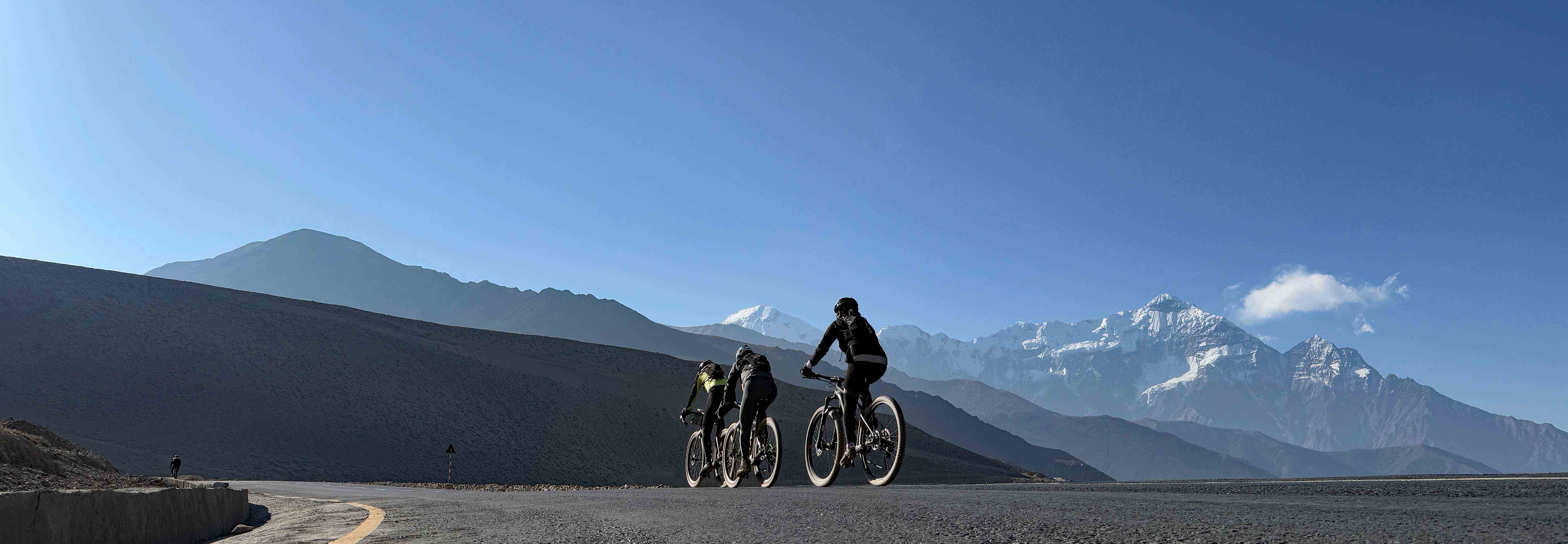
Not long after the bridge, the character of the route changed immensely as we rejoined a velvety smooth paved surface. After four days of riding on some pretty challenging trails, the difference was incredible and you could hear the whoops of delight from the different riders echoing down the valley. Weirdly, the paved road section gave me one of my favourite images from the entire trip. Getting good photographs requires a lot of calculated guess work as to what is going to happen 30 seconds or a minute into the future and I spend a lot of time second guessing how things will look, where the best light will be and what position I need to be in to make the most of it. This shot, with Dhaulagiri lit up in stunning early morning light beyond the riders, was taken by spreadeagling myself flat on the tarmac and shooting upwards as the riders rode past. Fortunately, the remote location and the early time of day meant there was no traffic, so despite appearances, it was perfectly safe!
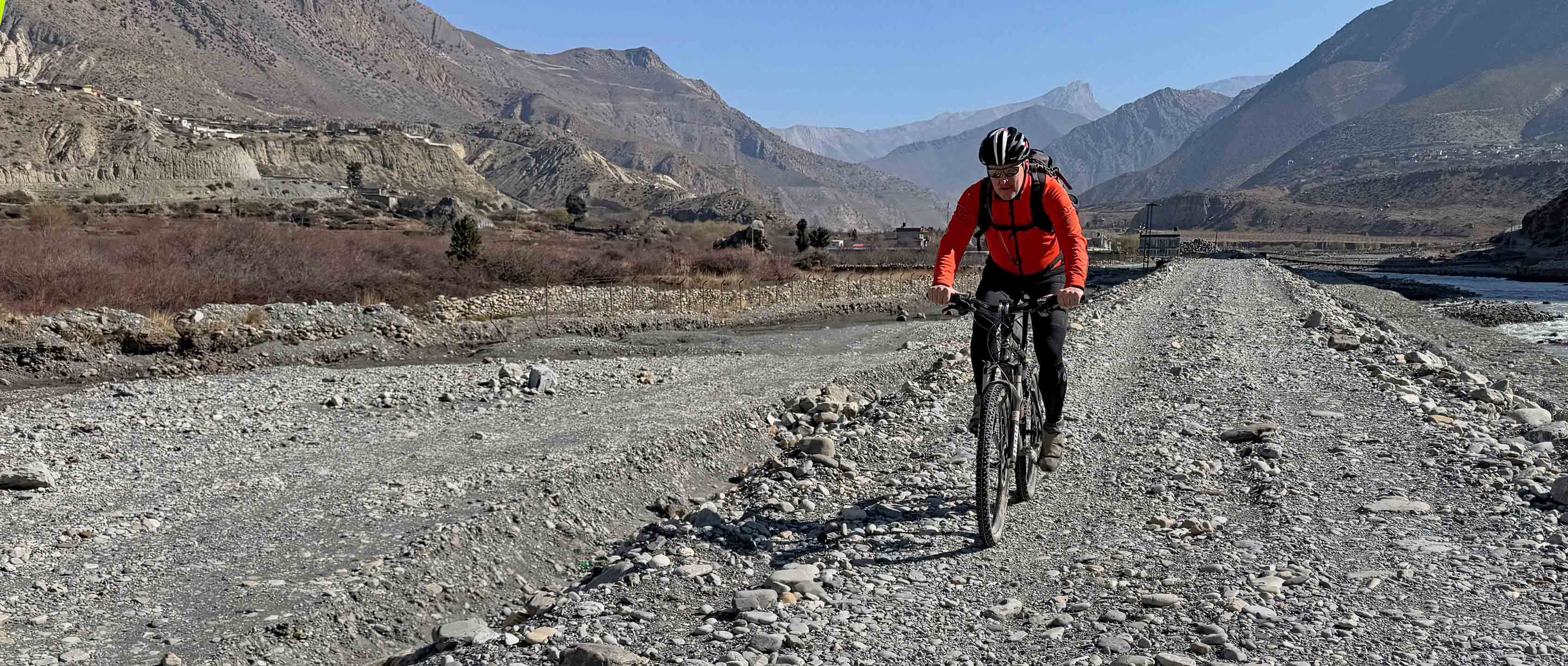
“My route is telling me to go left here” said Jan as we rode through the centre of the town of Jomsom. I knew from prior experience of riding in the area more than a decade previously that if we stayed on the left-hand side of the valley, we would soon end up on some pretty gnarly mountain bike trails. I had caught a glimpse of the rest of the riders in front heading right and crossing the river, retracing the route we had taken while heading north. Not wanting to leave Jan on his own (and with some local knowledge in my back pocket) I chased him and then followed his alternative route. It turned out that when he uploaded the GPX files he had set them as his default “MTB” option (rather than the gravel option that I had selected for mine) and on occasions his GPS unit had taken him off the route onto what it considered to be a more appropriate MTB option. I never need any encouragement to do a bit of underbiking, so we pushed on and enjoyed some super fun, albeit quite technical riding. As we headed south, I could see a suspension bridge coming up and I persuaded Jan that continuing on the MTB route option would see us ending up on some pretty serious terrain, so when the opportunity came up, we crossed the river so that we were back on the correct side.
"Jan became my partner in crime and I led him astray a couple of times in search of trails unknown."
While I had been researching the route in advance, I had spotted there were quite a few small villages just off our route and with a little careful wiggling, we could explore some lesser ridden trails while still heading in the right direction. After our earlier adventure, Jan became my partner in crime and I led him astray a couple of times in search of trails unknown. That undoubtedly sounds a little irresponsible, but by keeping an eye on where the main jeep road was in relation to us, we managed to ride a few lesser-known trails and stay within range of the other riders.
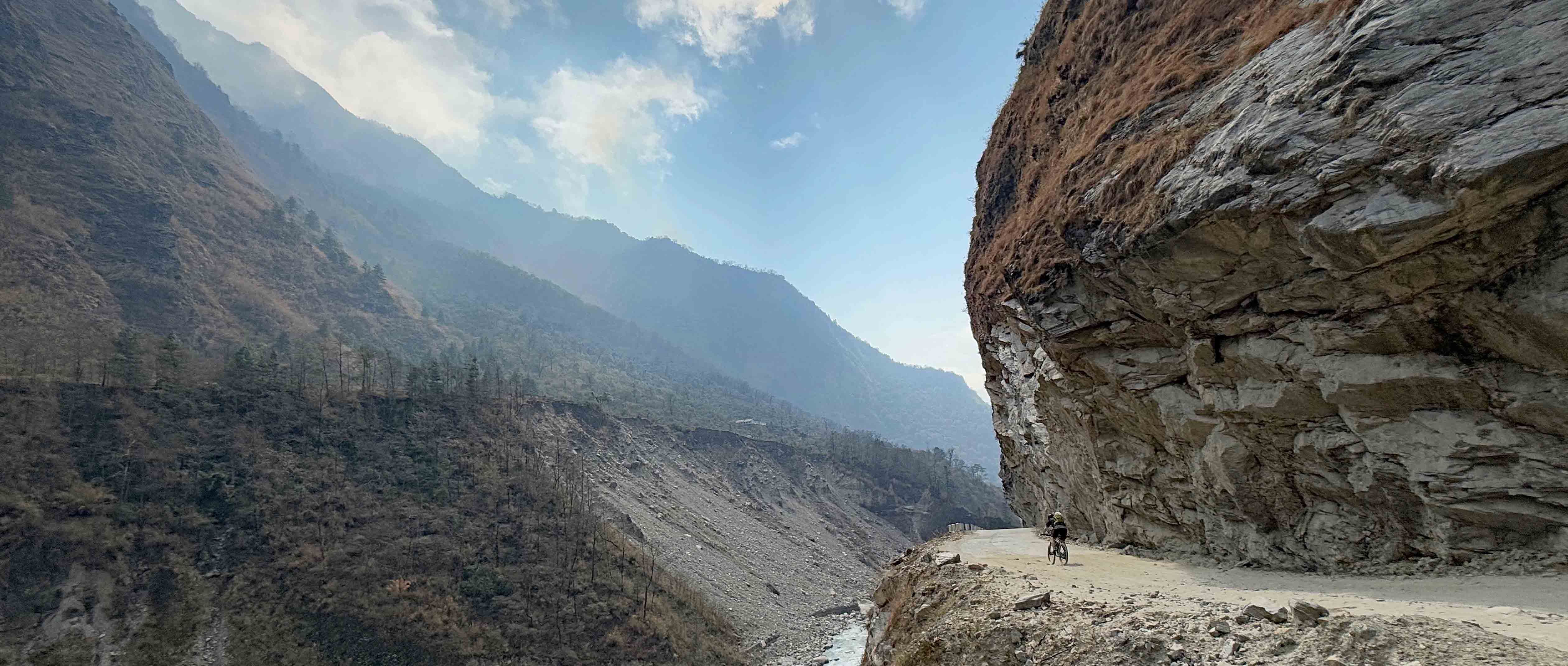
As we headed further south, the valley initially flattened out and widened dramatically, but after a few km of gently undulating riding, the route profile showed a steep descent and we seemed to fall off the edge of the world. In places the track clung on to a cliffside, hewn out from the rock by a combination of ingenuity and dynamite. At times I could see the MTB route that I had ridden previously directly opposite, again clinging to steep mountain sides. Oddly, it brought on pangs of melancholy. On my previous visit, the jeep trail we were now using was barely scratched into the hillside and due to its rudimentary nature, was only very sporadically used. Now however, it was two lanes wide for the majority and had quite heavy traffic in places. Although the construction of the road will make the lives of many of the village residents who live along its route dramatically better, from my selfish perspective, I much preferred the older, quieter, less polluted version!
"Despite the hardships of staying high up in the mountains, I really didn’t enjoy the sensations of being back in the urbanised world again."
The shock of arriving at our palatial overnight accommodation in Tatopani, home of the famous hot springs, was vast and I was actually quite downhearted about it. Despite the hardships of staying high up in the mountains, I really didn’t enjoy the sensations of being back in the urbanised world again. Fortunately, after a hot shower, some decent food and a good night’s sleep, my brain seemed to have adjusted and the next morning all was OK with the world again.
At our regular nightly briefing, Usha and Ajay warned us that the next day’s ride would be quite a shock to the system, as we would be riding with more traffic and through some urban areas. The route for Day Four was initially screamingly fast on a jeep track, which intermingled sections of perfect tarmac with sections of armageddon. Often the gravelly/rocky/sandy sections would appear with very little notice (and in sod’s law fashion, only when we were absolutely flying), but we communicated really well as a mini-peloton and everyone got through unscathed. As we dropped, the temperatures increased dramatically and the landscape seemed to change by the minute. 24 hours previously we had been in a pretty barren, inhospitable high mountain environment, now there were banana palms at the side of the road and tropical sounding birds flitted overhead.
Our overnight accommodation was the most spectacular and luxurious so far. Called (appropriately) The Cliff, it was built on the edge of vast steep sided valley and we approached it via Nepal’s second longest suspension bridge. We left our bikes and support vehicles on the north bank and then crossed on foot, carrying our hand baggage with us. Soon after and much to our embarrassment, a team of tiny female members of staff skipped across the bridge carrying our vastly heavy kitbags. Suddenly all those extra kilos of unworn or just-in-case clothing felt like a mistake. Even though it’s their job and it’s how they make their money, watching someone else smoothly carrying my kit bag across a bridge that we all struggled to walk across unladen barely 15 minutes before was a very odd experience. We tipped the ladies well in order to assuage some of the guilty feelings.
Day Five started bright and early as it was the ‘queen stage’. No-one could quite remember exactly why the biggest stage in a cycling event gets the queen stage moniker, but we just knew it was the longest and contained the most climbing. Our bags were efficiently ferried back across the bridge just after sunrise and we followed soon after, once breakfast had been ingested. Usha set a brisk pace along a mix of urban and rural tracks, the beautiful early morning light and warm temperatures seeming to urge everyone on like aspiring pro riders.
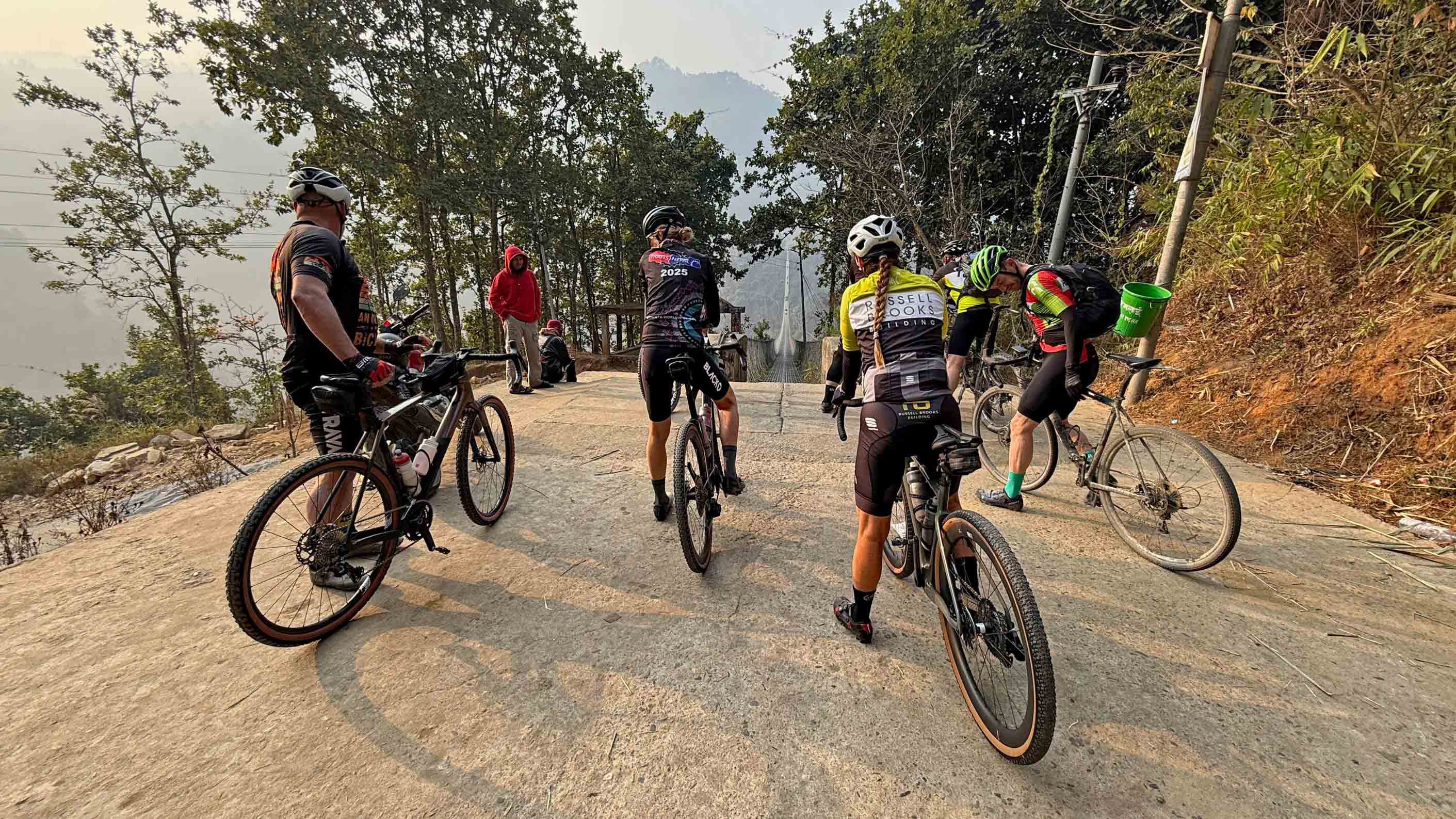
Having started the day with a foot crossing of a suspension bridge, we soon had a further two to tackle by bike. As we waited at the start of the first one for a small fleet of locals riding mopeds to finish their crossing, there was a palpable sense of excitement and nervousness. The first bridge was by far the biggest and the sag in middle was impressive. There was an unwritten rule about who gave way when you met oncoming traffic (luckily pretty rare) or pedestrians (who seemed to give way to everyone). Everyone was super friendly and considering how few cyclists apparently visit this area, our presence generated a 100% positive response (once the initial bewilderment had worn off).
"The route deteriorated (or improved, depending on your perspective) into a fantastically undulating gravel road."
In our nightly team briefing, Usha and Ajay had said that traffic levels would be dramatically lower today and their description was spot on. We cruised through a beautifully verdant agricultural landscape, lushly planted terraces visible on all sides. Initially much of the route was on beautifully smooth and quiet paved roads, but as the morning wore on and we started to climb, the route deteriorated (or improved, depending on your perspective) into a fantastically undulating gravel road. At regular intervals, landslides had historically wiped the track off the side of the mountain and crews were busy making repairs.
The initial part of the morning saw us gaining and losing height surreptitiously, but we knew at some point that the climbing proper would start. The first big climb was on tarmac and snaked its way up the side of a hill in full blazing sunshine. Having come from the frigid mountains, climbing in the heat of the lush tropical Nepali foothills came as quite a shock. Fortunately the gradient eased as we got higher and the crew had positioned the first of the day’s water stops at the top of the first ‘pitch’. After riding mainly small backroads in the morning, arriving onto our first wider road was quite a wake-up call. The traffic volume was light and the drivers impressively courteous, but you still had to concentrate as our speed and the speed of the passing vehicles increased dramatically.
We knew from the route profile that the majority of the day’s 3000m of climbing was scheduled for the last 20 km and the crew had appropriately positioned a water stop just before the start of the final monster ascent. They had the normal spread of drinks and snacks, but after having my fill I was still hungry and decided that doing the bulk of the climbing on a relatively empty stomach was a recipe for running out of energy. With Usha’s translating skills bought into play, Nat and I decided that a bowl of hot veg noodle soup and a cold bottle of pop was the ideal preparation and so Team Noodle convened its inaugural outing by sitting on the concrete steps outside the café and practically inhaling some well-spiced soup.
The climb was pretty brutal, with a killer combination of heat, steepness of gradient, looseness of surface and strong headwinds thrown our way over the course of 20km. The ever changing nature of the climb was both a blessing in that your mind and body were permanently occupied trying to ride appropriately for the condition, but also it made it much harder to find a rhythm. I started off near the back, chatting with different riders and shooting images as we climbed, but eventually I realised that my legs were starting to feel the benefit of the previous days’ altitude ‘training’ and so I upped the pace and made my way steadily through the field. Roughly at the halfway point I met up again with Nat, my Team Noodle partner and we teamed up for the remaining section to the summit. Our speeds managed to mesh perfectly and we could share the work of riding into the headwind in the upper sections.
"Nat had the last laugh by setting a new QOM time for the climb!"
Despite the fact we had GPX files, we were essentially riding the climb blind and we had no real idea of what was coming up next. As the gradient eased off towards the top, we caught up with two fellow riders Dom and Ali and ended up riding as a quad on the ridgeline section towards the end. Thinking we had got the worst out of the way, we upped the pace as the finish line came metaphorically into sight, only to find a series of short ramps and a gusty headwind to welcome us at the highest part of the route. With a short distance to go to hotel, Ali jumped off the front to claim the kudos for getting to the hotel first, but Nat had the last laugh by setting a new QOM time for the climb!
We woke up on our final cycling day to find unusually murky, grey conditions. The hotel was situated at more than 1400m and the day was due to start with a vast 40km descent down into the ‘terai’ – the flat region on the Nepali-Indian border. Usha warned us about the risks of the first descent and she wasn’t wrong – the descent was super-fast, but included numerous hairpin bends in the first section (ridden in quite heavy traffic) and then a vision of dystopia in the second part. The road was being upgraded (courtesy of Chinese State funding) through the construction of vast numbers of cuttings and tunnels. While in the long term this will undoubtedly bring benefit in the short term it meant high levels of construction traffic and unbelievable levels of dust. Everyone was completely caked in it by the time we reached our first water fill-up point near the town of Butwal.
"Everyone seemed to have some last-day-at-school energy about them and we ratcheted up the speed on the final sections of dirt road."
The final section of the ride was by far my favourite, if for no other reason than we were back in the land of the bicycle. These weren’t bikes used for pleasure though – these were bikes used as everyday transport. Ridden by everyone from school children to nattily dressed gentleman complete with what appeared to be a silk scarf, it was brilliant to see so many bikes out on the roads. Our route was a mixture of quiet backroads (a joy after the business and dust of the main road) and some ridiculously good fun strade bianche-esque sections of dirt roads. Everyone seemed to have some last-day-at-school energy about them and we ratcheted up the speed on the final sections of dirt road.
Usha did her normal amazing job of marshalling the troops and everyone made it through the various twist, turns, junctions and villages that dotted our route. Everyone had been watching their computer screens tick off the distance, but the end still came as quite a surprise. One final section of riding along a wider urban road, a shart left hand-turn through the gates and we had arrived at our final destination in the city of Lumbini.
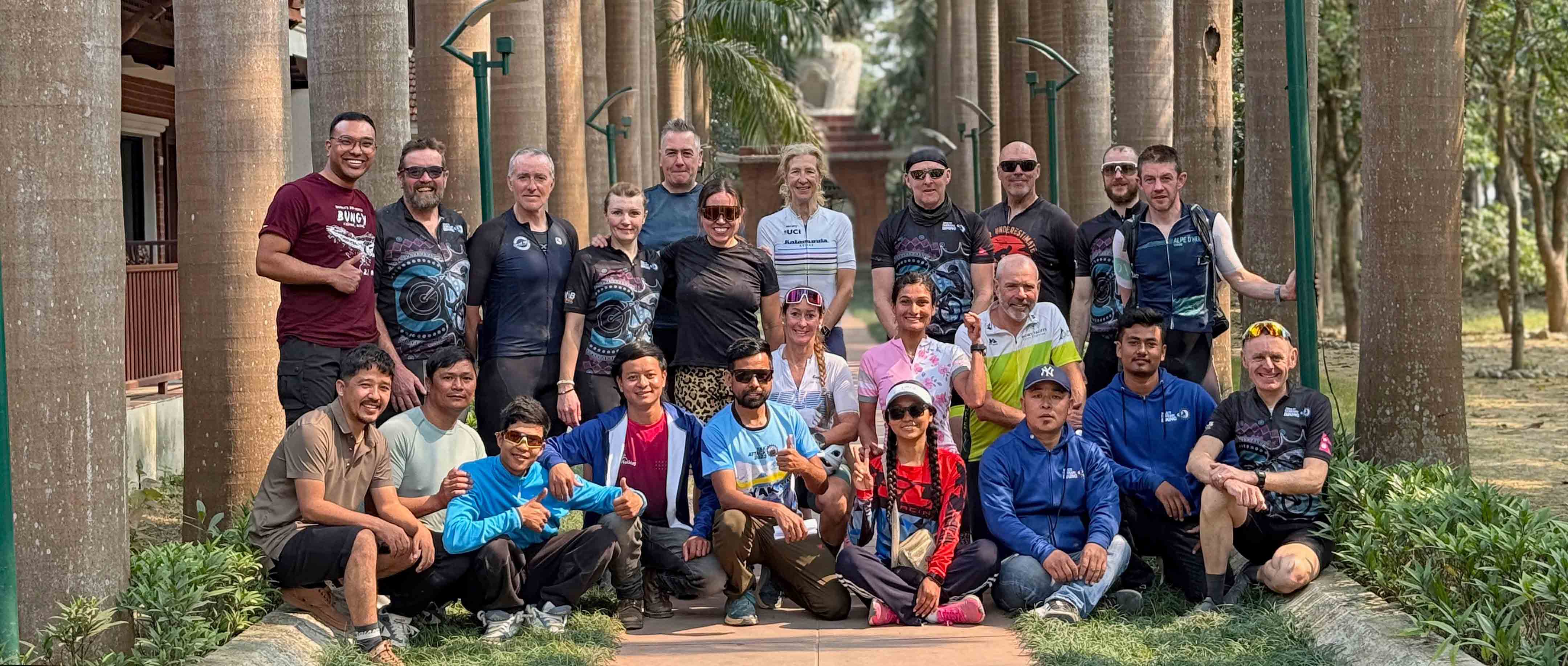
There was a palpable air of sadness that our journey was over, but also an immense sense of pride, happiness and
Relief that we had made it safely from the top of the Nepal to the bottom (well, nearly anyway). With faces and bodies still liberally coated in road dust, we gathered for one final photo in the shade of a palm grove in the hotel’s garden – Team Trans-Nepal 2025 together for one final time.
If you are interested in taking part in the next Trans-Nepal Gravel, which will be held in December 2025, you can find the full details here. Prices start from US$1995 per person.
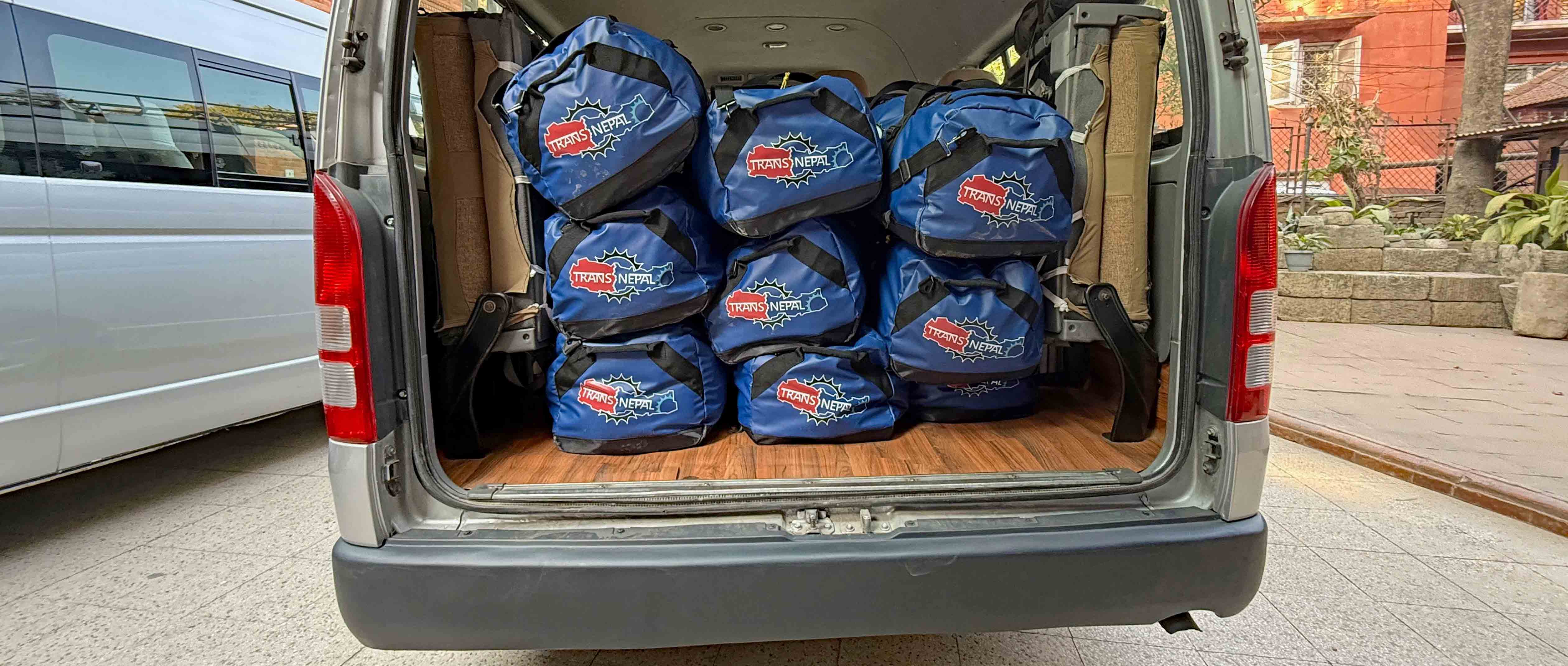
Travel trauma – Unless you are fortunate to already live in Nepal, anyone taking part in the Trans-Nepal Gravel will need to fly to get there. Long haul flights, particularly with a bike in tow, can be both expensive and stressful – the worry about whether your bike will arrive intact often creates a small black cloud over the start of the trip. Fortunately, my bike arrived safely. My wallet on the other hand was not so lucky! When I researched all the available flight options, travelling with Emirates from where I live in the UK was the fastest and least complicated route (with just one change in Dubai). Unfortunately, unlike some of their competition, Emirates offer no facilities at all for cyclists – it’s not possible to pay for an extra bag in advance and they don’t offer any discounts for bringing sporting equipment (which is what most airlines classify bikes as). Whereas airlines like British Airways offer a fixed price for travelling with a bike (as long it the total weight of your bike bag is below 30kg), Emirates charge per kg. I stupidly didn’t realise this until I had already booked my seat and contacted them to add a bike to my booking. Not only do they not offer the ability to add a bike to your booking, you can’t buy extra weight allowance in advance so have to put up with the extra cost and hassle of buying extra allowance at the airport as you drop you bags off. For the outbound flight, it was "only" £100 extra, but on the way home, despite the fact I was travelling with 3kg less weight overall, I was charged over £300 for my bike. Despite remonstrating with the check-in team about how unreasonable this was, they were completely inflexible and my complaints fell on deaf ears. Suffice to say, I won’t be travelling with my bike on Emirates in the future and I would advise you to look elsewhere for long-haul travels with your bike too!